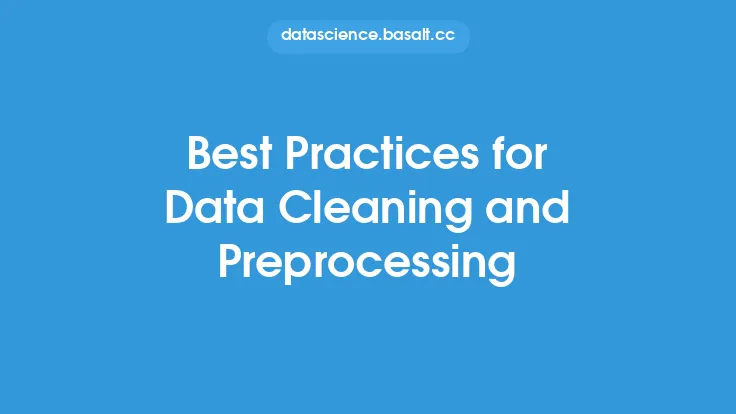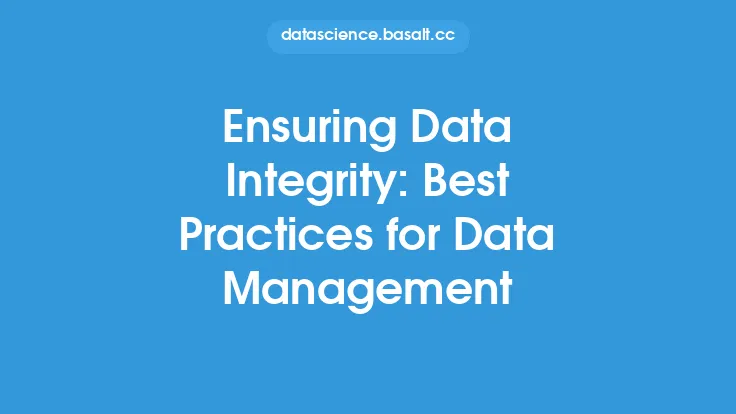Data ingestion is a critical component of the data engineering process, as it enables organizations to collect, process, and analyze large volumes of data from various sources. However, ensuring data quality and reliability during the ingestion process is crucial to prevent errors, inconsistencies, and inaccuracies that can have significant consequences downstream. In this article, we will discuss the best practices for data ingestion, focusing on the technical and procedural aspects that can help organizations ensure data quality and reliability.
Introduction to Data Ingestion Best Practices
To ensure data quality and reliability, it is essential to establish a robust data ingestion framework that includes several key components. First, data sources must be identified and evaluated to determine their relevance, accuracy, and completeness. This involves assessing the data format, structure, and quality, as well as the frequency and volume of data generation. Next, data ingestion tools and technologies must be selected and configured to handle the specific requirements of each data source. This may involve using APIs, messaging queues, or file transfer protocols to collect and transport data. Finally, data must be processed, transformed, and loaded into a target system, such as a data warehouse or data lake, for analysis and visualization.
Data Source Evaluation and Selection
Evaluating and selecting data sources is a critical step in the data ingestion process. This involves assessing the quality, accuracy, and completeness of the data, as well as its relevance to the organization's goals and objectives. Data sources can be categorized into several types, including structured, semi-structured, and unstructured data. Structured data, such as relational databases, is highly organized and easily searchable, while semi-structured data, such as XML or JSON files, has some level of organization but does not conform to a rigid format. Unstructured data, such as text documents or images, lacks any discernible structure or organization. When evaluating data sources, it is essential to consider factors such as data format, data quality, and data volume, as well as the frequency and latency of data generation.
Data Ingestion Tools and Technologies
A wide range of data ingestion tools and technologies are available, each with its strengths and weaknesses. Some popular options include Apache NiFi, Apache Kafka, and Apache Beam, which provide scalable and flexible solutions for data ingestion. These tools offer features such as data processing, transformation, and loading, as well as data quality checking and error handling. When selecting a data ingestion tool, it is essential to consider factors such as scalability, performance, and ease of use, as well as the level of support and documentation provided. Additionally, organizations should evaluate the tool's ability to handle different data formats and sources, as well as its integration with other tools and systems.
Data Processing and Transformation
Data processing and transformation are critical steps in the data ingestion process, as they enable organizations to convert raw data into a usable format. This involves applying various techniques, such as data cleaning, data mapping, and data aggregation, to ensure that the data is accurate, complete, and consistent. Data processing and transformation can be performed using a variety of tools and technologies, including Apache Spark, Apache Flink, and Python libraries such as Pandas and NumPy. When processing and transforming data, it is essential to consider factors such as data quality, data consistency, and data scalability, as well as the level of complexity and sophistication required.
Data Quality Checking and Error Handling
Data quality checking and error handling are essential components of the data ingestion process, as they enable organizations to detect and correct errors, inconsistencies, and inaccuracies in the data. This involves applying various techniques, such as data validation, data verification, and data reconciliation, to ensure that the data is accurate, complete, and consistent. Data quality checking and error handling can be performed using a variety of tools and technologies, including data quality software, data governance platforms, and custom-built applications. When implementing data quality checking and error handling, it is essential to consider factors such as data complexity, data volume, and data velocity, as well as the level of automation and manual intervention required.
Data Security and Governance
Data security and governance are critical aspects of the data ingestion process, as they enable organizations to protect sensitive data and ensure compliance with regulatory requirements. This involves applying various techniques, such as data encryption, data masking, and access control, to ensure that the data is secure and accessible only to authorized personnel. Data security and governance can be performed using a variety of tools and technologies, including data security software, data governance platforms, and compliance frameworks. When implementing data security and governance, it is essential to consider factors such as data sensitivity, data risk, and data compliance, as well as the level of automation and manual intervention required.
Monitoring and Optimization
Monitoring and optimization are essential components of the data ingestion process, as they enable organizations to detect performance issues, optimize data flow, and improve data quality. This involves applying various techniques, such as data monitoring, data logging, and data analytics, to ensure that the data ingestion process is running smoothly and efficiently. Monitoring and optimization can be performed using a variety of tools and technologies, including data monitoring software, data analytics platforms, and custom-built applications. When implementing monitoring and optimization, it is essential to consider factors such as data volume, data velocity, and data complexity, as well as the level of automation and manual intervention required.
Conclusion
In conclusion, ensuring data quality and reliability during the data ingestion process is crucial to prevent errors, inconsistencies, and inaccuracies that can have significant consequences downstream. By following best practices such as data source evaluation and selection, data ingestion tool selection, data processing and transformation, data quality checking and error handling, data security and governance, and monitoring and optimization, organizations can establish a robust data ingestion framework that enables them to collect, process, and analyze large volumes of data from various sources. By prioritizing data quality and reliability, organizations can unlock the full potential of their data and make informed decisions that drive business success.





